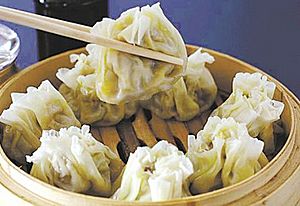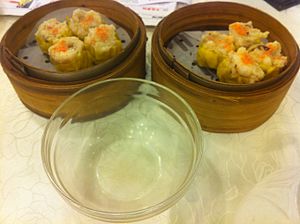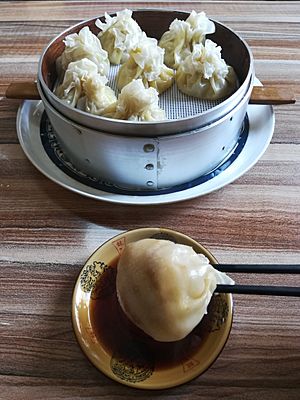Shumai facts for kids
Shumai (also spelled shaomai, shui mai, siu mai, or sui mai) is a delicious type of traditional Chinese dumpling. It's often served as a dim sum snack, which is like a meal with many small dishes. You can find shumai not only in China but also in places like Japan and many countries in Southeast Asia.
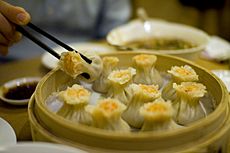 |
|
| Alternative names | Variously spelled shaomai, shui mai, shu mai, sui mai, shui mei, siu mai, shao mai, xíu mại (Vietnamese) |
|---|---|
| Course | Dim sum |
| Place of origin | China |
| Region or state | Guangzhou, Guangdong or Hohhot, Inner Mongolia |
| Main ingredients | seasoned ground pork, whole and chopped mutton, Chinese black mushroom, lye water dough |
| Variations | Siomay |
| Shumai | |||||||||||||||||||||||||
|---|---|---|---|---|---|---|---|---|---|---|---|---|---|---|---|---|---|---|---|---|---|---|---|---|---|
| Chinese name | |||||||||||||||||||||||||
| Traditional Chinese | 燒賣 | ||||||||||||||||||||||||
| Simplified Chinese | 烧卖 | ||||||||||||||||||||||||
| Jyutping | siu1 maai2 | ||||||||||||||||||||||||
| Hanyu Pinyin | shāomài | ||||||||||||||||||||||||
| Literal meaning | to cook and sell | ||||||||||||||||||||||||
|
|||||||||||||||||||||||||
| Vietnamese name | |||||||||||||||||||||||||
| Vietnamese alphabet | xíu mại | ||||||||||||||||||||||||
| Chữ Hán | 燒賣 | ||||||||||||||||||||||||
| Thai name | |||||||||||||||||||||||||
| Thai | ขนมจีบ [kʰā.nǒm.t͡ɕìːp] | ||||||||||||||||||||||||
| RTGS | khanom chip | ||||||||||||||||||||||||
| Japanese name | |||||||||||||||||||||||||
| Kanji | 焼売 | ||||||||||||||||||||||||
| Kana | シュウマイ | ||||||||||||||||||||||||
|
|||||||||||||||||||||||||
| Indonesian name | |||||||||||||||||||||||||
| Indonesian | siomai / siomay / somay | ||||||||||||||||||||||||
| Filipino name | |||||||||||||||||||||||||
| Tagalog | siomai / siyomay | ||||||||||||||||||||||||
| Hindi name | |||||||||||||||||||||||||
| Hindi | momo | ||||||||||||||||||||||||
Contents
Different Kinds of Chinese Shumai
There are many different kinds of shumai across China. Each region has its own special way of making this dumpling. Let's explore some of the most popular ones!
Hohhot Shaomai
In Hohhot, a city in Inner Mongolia, they make a unique kind of shaomai. The wrapper is very thin and round, made from dough without yeast. It has a pretty pleated edge.
The filling is usually made of chopped or minced mutton (lamb meat), lots of scallions, and ginger. This gives Hohhot shaomai a strong, spicy flavor. The filling is placed in the middle, and the wrapper is gathered loosely at the top, making it look like a flower.
These dumplings are either steamed or pan-fried. They are often served in groups of eight, called a "liang." Because they can be a bit greasy, people usually eat them with vinegar and tea.
Cantonese Siumaai
This is probably the most famous type of shumai outside of Asia. It comes from the southern Chinese provinces of Guangdong and Guangxi. In Cantonese cuisine, it's often called "pork and mushroom dumpling."
The main ingredients for the filling are ground pork, small whole or chopped shrimp, Chinese black mushrooms, scallions, and ginger. They are seasoned with rice wine, soy sauce, sesame oil, and chicken stock. Sometimes, bamboo shoots, water chestnuts, and pepper are added too.
The wrapper is a thin sheet of yellow or white dough. The top is often decorated with an orange dot, usually made from crab roe (fish eggs) or diced carrot. Sometimes, a green pea is used instead.
In Hong Kong, you can find a fish paste version of siumaai sold as a popular street food. People often eat it with sweet soy sauce or chili oil.
Hunan Juhua Shaomai
This type of shaomai is made in Changsha, Hunan province. It's called "chrysanthemum shaomai" because its open top looks like a chrysanthemum flower. This dumpling is spicy with pepper, and its wrapper is almost see-through. The filling is mostly glutinous rice, pork, shrimp, shiitake mushrooms, bamboo shoots, and onion.
Jiangnan Shaomai
Shaomai from the Jiangnan region, which includes cities like Shanghai and Nanjing, has a filling similar to zongzi (another Chinese food). It contains marinated pork pieces mixed with glutinous rice, soy sauce, and Shaoxing wine. It's steamed with pork fat and is usually bigger than the Cantonese version.
The Shanghai version also includes shiitake mushrooms and onion. These ingredients are often stir-fried before being used as the filling.
Uyghur Shaomai
In northwest China, the Uyghur people in Xinjiang have their own versions of shaomai. The recipes are a bit different between northern and southern Xinjiang. The northern version uses mutton or beef with scallions and radish. The southern version mainly uses glutinous rice with smaller amounts of mutton or beef. Minced meat from sheep ribs with some fat is considered the best for this type.
Jiangxi Yifeng Shaomai
This shaomai from Yifeng in Jiangxi province has a special flavor. It comes from a mix of pork mince, bread flour, sesame seed powder, ground pepper, and sugar. It's very popular in the Yifeng Tanshan Tianbao area, especially during Chinese New Year celebrations.
Shumai in Other Countries
Shumai has traveled around the world and changed to fit local tastes!
Japanese Shūmai
In Japan, shūmai usually has pork and minced onion as the main ingredients. They are often topped with a green pea. The meat filling in Japanese shumai is usually ground into a paste, which is different from the more minced meat in Chinese shaomai.
Indonesian Siomay
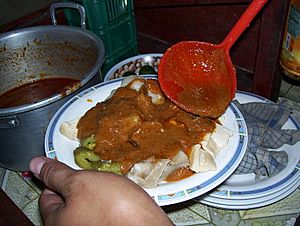
In Indonesia, siomay (or siomai) is often made with a wonton wrapper, stuffed with a filling, and then steamed. It's usually served with steamed potatoes, tofu, hard-boiled eggs, steamed bitter gourd, and cabbage. All these ingredients are sliced and topped with a tasty peanut sauce and kecap manis (sweet soy sauce).
Since many people in Indonesia are Muslim, pork siomay is rare. Instead, it's usually made from different kinds of fish, like wahoo or mackerel tuna.
Philippine Siomai
In the Philippines, siomai often contains ground pork, beef, or shrimp. It's mixed with ingredients like garlic, green peas, and carrots, then wrapped in wonton wrappers. It's commonly steamed, but a popular version is also fried until it's crispy on the outside. People usually dip it in soy sauce with calamansi (a Philippine lime) juice. Sometimes, chili-garlic oil is added to the sauce for extra flavor.
A newer type of siomai is wrapped in sheets of laver (seaweed) after the wonton wrappers, and these are sometimes called "Japanese" siomai.
Vietnamese Xíu Mại
In Vietnam, xíu mại has minced pork, onion, scallions, and shredded bread as its main ingredients. It's cooked in a tomato sauce. This dish is often served inside a bánh mì roll for breakfast. Because it doesn't have a dough wrapper, it's more like a meatball than a traditional shumai dumpling.
History of Shumai
Historical records show that shaomai was first served in tea houses as a side dish. The name "simplified Chinese: 捎卖; traditional Chinese: 捎賣" meant that it was "sold as a sideline" along with tea. It's believed that merchants from Shanxi province brought it to Beijing and Tianjin, which helped it become popular across China.
The name later changed to modern forms like "燒麥" or "燒賣." The characters changed, but the sound stayed the same. At first, it was meat and vegetables wrapped in thin sheets. The tradition of weighing only the wrapper when selling it is still kept in Huhhot today.
How Shumai is Served
In Huhhot, Shaomai is often eaten as a main meal, especially for breakfast. It's a local favorite there. Steamed ones are served in special steamer baskets, and fried ones are served on dishes, usually eight at a time. Vinegar is commonly used as a dipping sauce, and people often drink tea with it.
In southern China, shaomai is one of the most common dishes in the dim sum tradition. It's usually served with har gow, another type of steamed dumpling with shrimp. Together, they are known as har gow-siu mai.
In Guangzhou, siu mai, har gow, char siu bao (steamed pork buns), and egg tarts are considered the classic dishes of Cantonese dim sum. They are even called The Four Heavenly Kings of the cuisine.
In Indonesia, siomay is eaten with steamed vegetables and tofu, all covered in spicy peanut sauce.
In the Philippines, siomai is eaten on its own, with a dipping sauce, or with rice.
See also
 In Spanish: Shaomai para niños
In Spanish: Shaomai para niños


